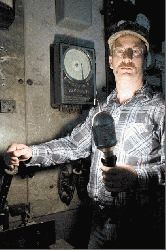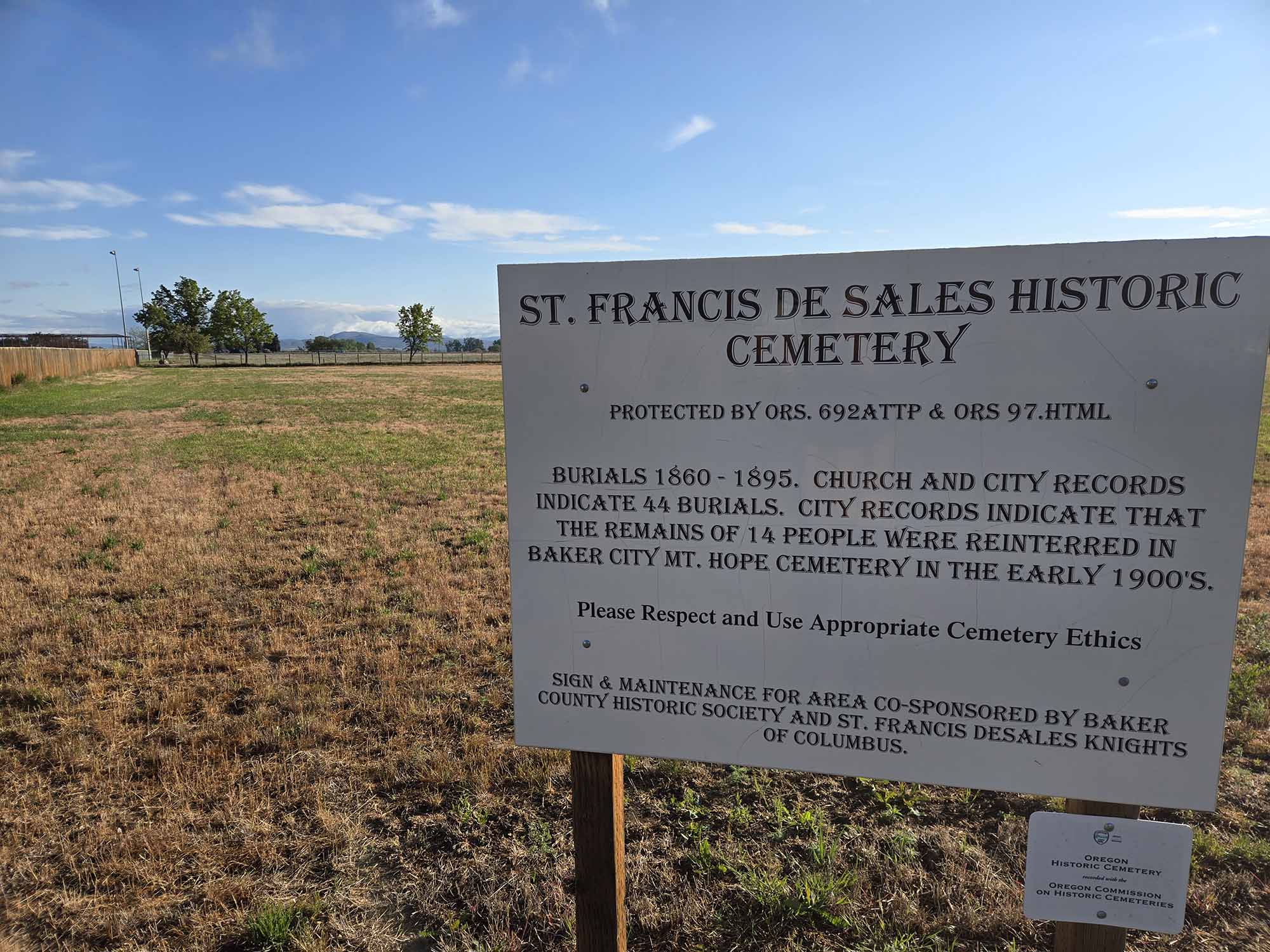Power of the past
Published 12:00 am Friday, June 27, 2008

- Mark Henderson hopes to turn on power to the Rock Creek Power Plant in the future with help from his wife, Tammy, and brother Doug. The Hendersons are working to restore the plant to produce electricity. The plant operated from 1905 until 1995. (Baker City Herald File Photo/Alex Pajunas).
By TALIA SCHMIDT
Trending
Baker City Herald
Mark Henderson isn’t afraid of a challenge. He knows that hard work combined with patience and the desire to preserve an historic landmark are the key ingredients to completing a project.
After 13 years of serving as little more than historical decoration, the Rock Creek Power Plant tucked into the Elkhorn Mountains about six miles west of Haines is well on its way to making a comeback.
Trending
Or so Henderson hopes.
First, Henderson and his brother, Doug, have to ensure the 105-year-old plant is ready and safe. The structure still has several hoops to jump through before it passes federal government inspection and can again spit out the kilowatts, as it did for almost a century.
andquot;We’re currently relicensing the plant with the federal government,andquot; Mark Henderson. andquot;But the relicensing process takes anywhere from five and a half to seven years. We’re two and a half years into it.andquot;
Built in 1903, the hydroelectric power plant has been modified a bit with minor tweaks to the roofing and the addition of some switches. But overall, a majority of the plant’s equipment is the century-old original.
Henderson takes great pride in the plant’s authenticity. Nearly every other power plant in Oregon has upgraded its controls at least twice in decades past, he said.
In a dark, dusty room inside the plant, Henderson gazes at the clock works recorder, which measured the electrical production.
He heaves a hopeful sigh.
andquot;One day, this meter will be running again,andquot; he said. andquot;It’s like the heartbeat of the plant.andquot;
Rock Creek Power Plant took its last breath on March 31, 1995. The two Pelton water wheels connected to a General Electric generator, built in 1903, turned for the last time and the granite building has remained eerily quiet ever since.
A series of owners including CP National, Oregon Trail Electric Cooperative and finally the Henderson brothers, who bought the plant in 2005, have all invested time and effort in the plant.
But restoring the plant is not a completely private undertaking.
The Hendersons must comply with regulations and update several agencies about their progress, including the Oregon Department of Justice, the Oregon Department of Forestry and the U.S. Fish and Wildlife Service.
andquot;We have about 14,000 sheets of paper in drafts so far,andquot; Mark Henderson said. andquot;FedEx loves us at this time.andquot;
andquot;OTEC couldn’t afford to license it anymore,andquot; he said. andquot;With all the studies the plant’s owner must complete, it might take years and thousands of dollars before the old plant produces power.andquot;
The agency that issues licenses for power plants, the Federal Energy Regulatory Commission, requires several studies.
Henderson said the environmental studies he must complete include ones dealing with fisheries, wetlands and any tree-cutting that might be necessary.
Steve Schauer, manager of member services for OTEC, said the cooperative decided that renovating the plant was not cost-effective.
andquot;The OTEC board of directors took a close look at relicensing the general facility,andquot; said Schauer. andquot;We would have needed to do a significant amount of maintenance. When we crunched the numbers on that, it was not cost effective.
andquot;Since the cost of the power coming out of it would be quite high, we thought we could buy electricity at other entities for lower costs,andquot; Schauer said.
But Mark Henderson has faith in what he calls a andquot;treasure trove.andquot;
He and his brother are already gearing up to lead tours of the historic plant for the third year in a row.
Tours will open to the public on July 1 and run until July 7 from 8 a.m. to 5 p.m. and again from July 17 through July 20. The tours are free with admission to the Eastern Oregon Museum in Haines.
andquot;We originally always wanted to make public tours, like the mining museum in Sumpter,andquot; Mark Henderson said.
Henderson said he tailors the tours to his guests’ interests.
andquot;People have all different interests,andquot; said Henderson. andquot;If someone’s wanting a technological tour, we give them that. If they want a local renewable energy tour, we give them that.andquot;
Last year, the brothers had about 100 people turn out over the dozen or so days they offered tours.
andquot;The people who come out are real interested,andquot; said Henderson. andquot;We enjoy sharing our treasure trove.andquot;
Though the plant attracts some guests from the Baker City Herald’s Visitor’s Guide, Henderson said a majority of the so called andquot;touristsandquot; actually live nearby.
Some guests are revisiting the plant for the first time in two or three decades.
An Arizona man in his mid 50s took a tour of the plant and told Henderson he moved from Baker City to Arizona when he was 10 or 11. Much to Henderson’s delight, the man even brought some old pictures of the plant.
andquot;Our biggest goal with the tours is to convey the effort and work it took to put the plant in and run it back then,andquot; said Henderson. andquot;Now, a lot of plants are computer-operated, but back then plants were continually manually readjusted. There’d be an operator in the plant 24/7.andquot;
Although built to power mines in the Elkhorn Mountains, the Rock Creek plant’s electricity also illuminated homes in Baker Valley.
andquot;When the plant was first put in, electricity cost the same price as it does now,andquot; said Henderson. andquot;Back then, that was horrendously expensive.andquot;
Henderson said only some people could afford it.
Back in the early 1900s, houses didn’t require much power. But today, Henderson said the plant couldn’t supply enough power for Baker City.
andquot;On a nice day like today, we could maybe power Haines,andquot; said Henderson.
However, Henderson said he intends to install computers to run the plant, which will increase its efficiency.
Depending on the month and season, however, there may not be enough water to produce power.
That’s why the Hendersons have a back up plant.
The computer will route the water through the back up plant, which Henderson hopes will be significantly bigger than the main plant. They should be able to use less than half the water in the creek and still power both the back up and main plants.
Henderson said they’re able to upgrade the back up plant thanks to a bill the Oregon Legislature passed last summer to expand the scope of the state’s Business Energy Tax Credit (BETC). The bill andquot;nearly tripled the amount of credit available for projects that produce electricity from renewable resources and for manufacturers of equipment that uses renewable resources.andquot;
Henderson estimated that half the hydroplants in Oregon are computer-run.
andquot;It cuts down on maintenance,andquot; said Henderson. andquot;You still have to check it manually once a day.andquot;
The beauty of it, Henderson said, is that in the near future, he’ll be able to monitor the plant from afar. He said he’ll be able to sit in Mad Matilda’s on Main Street in Baker City and use his laptop to monitor what’s happening up at Rock Creek.
andquot;It’s the best of both worlds,andquot; said Henderson. andquot;We can preserve the integrity of our treasure trove while optimizing computer control for efficiency.andquot;
Henderson said he’s grateful to OTEC for preserving the power plant in its pristine state.
Schauer said OTEC no longer plays a role in the plant’s future. But if the Hendersons truly get the place up and running, Schauer said OTEC would be interested.
He acknowledges that resuscitating a relatively tiny hydroelectric plant after all these decades is no small feat.
andquot;We wish them the best of luck to get it back on the (power) line,andquot; Schauer said. andquot;We’d be pleased with that. We’re not sure what the output would be and at what cost the power would be priced at. But we’d be willing to purchase the power if it was reasonable.andquot;








